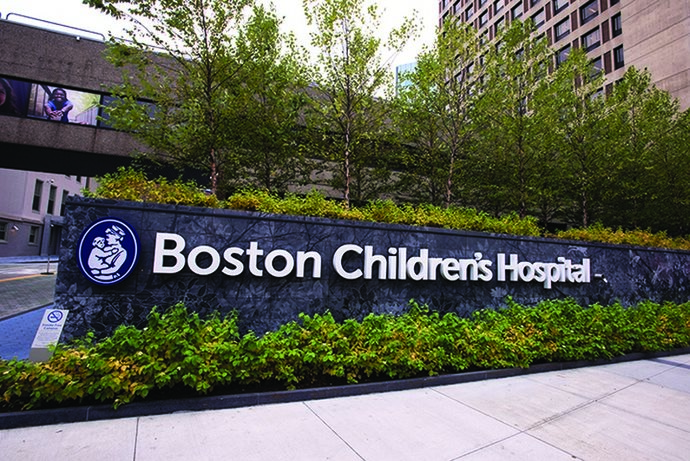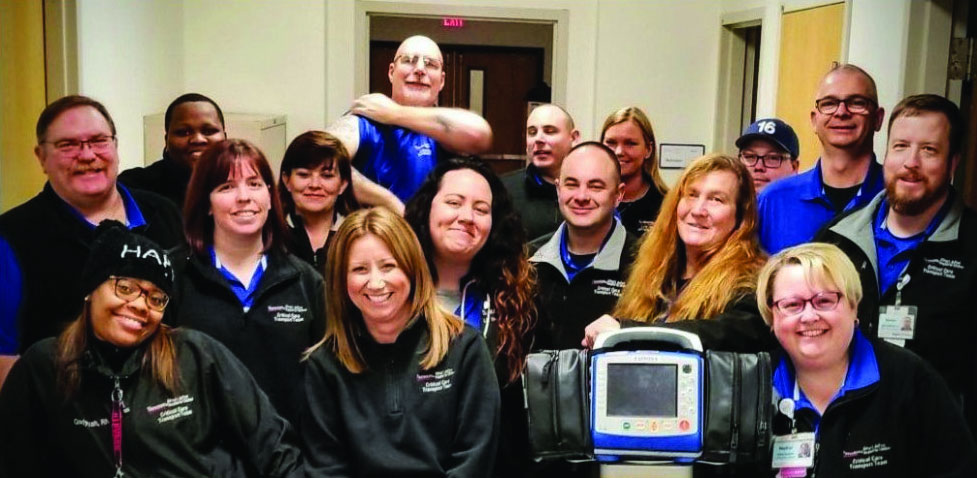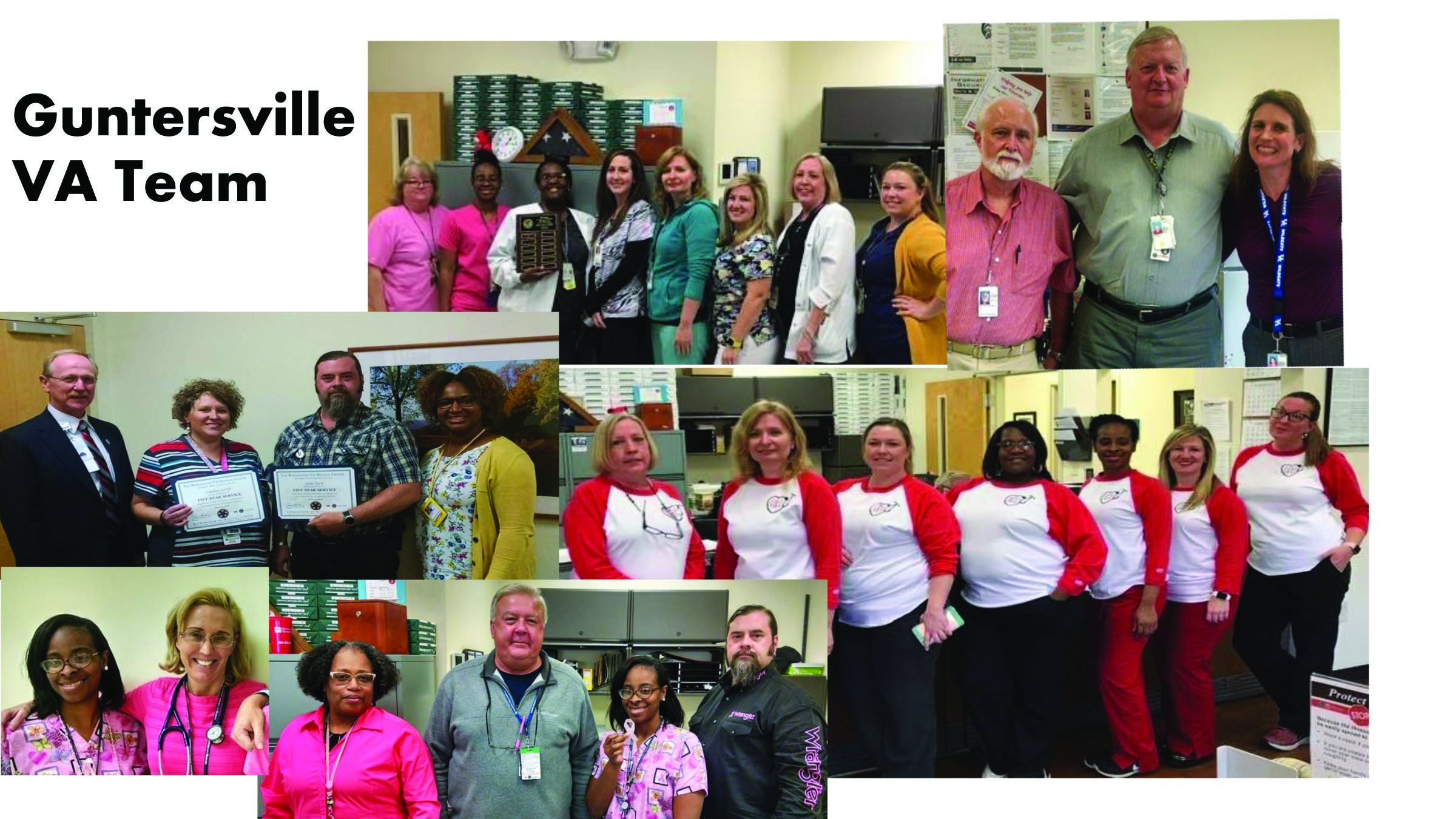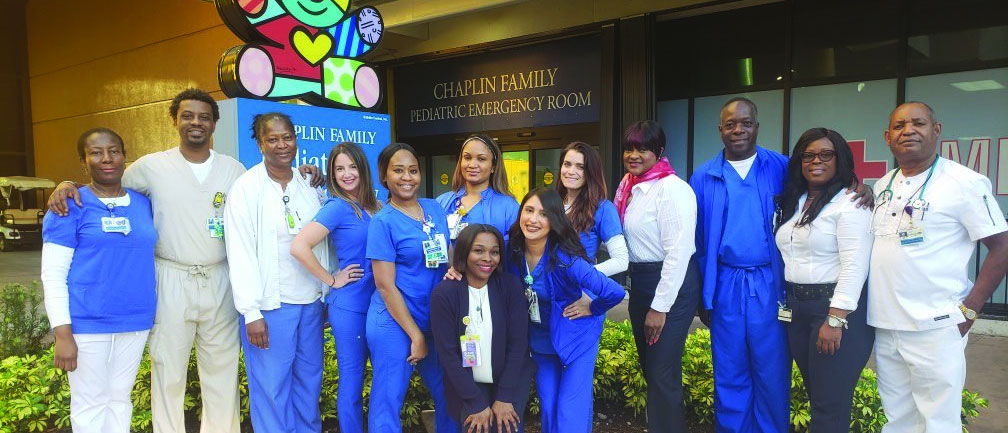In honor of National Nurses Week 2019 (May 6 to 12), this special section of American Nurse Today celebrates the winners of the annual All-Pro Nursing Team Awards.
We invited teams from around the country to tell us why they’re an all-pro nursing team. They shared insights about their communication techniques, cultures of professionalism, and decision-making strategies. They also shared stories from 2018 that demonstrate their unique team contributions to a significant healthcare outcome. Some of the stories are about a specific patient situation and others focus on quality improvement and innovation.
This year’s judges, which included nurses and American Nurse Today editorial staff, reviewed 48 entries. Each entry told a compelling story of teamwork and patient care, making the final decision difficult. In the end, the judges declared the Boston Children’s Hospital Cardiac Acute Care Unit Nursing Leadership Team the 2019 winner. You can read their story, and those of the three runners-up and 12 honorable mention teams, in the following pages.
American Nurse Today celebrates the dedication, commitment, patient advocacy, and clinical expertise of all nurses. All-Pro Nursing Team Award winner: Boston Children’s Hospital Cardiac Acute Care Unit Nursing Leadership Team


Leadership with heart
FIRST PLACE
Boston Children’s Hospital Cardiac Acute Care Unit Nursing Leadership Team
This winning team’s motto is “The only thing consistent on our unit is change.” That motto has come in handy as patient acuity and complexity increase. The Boston Children’s Hospital Cardiac Acute Care Unit (CACU) Nursing Leadership Team faces change head on with a flexible yet evidence-based approach. The team includes the nursing director, clinical coordinators, nurse educators, clinical nurse specialists (CNSs), clinical research coordinator, infection control nurse, and a senior administrative associated. Together, they quickly and systematically evaluate new therapies and innovations for safety concerns and patient benefits and then initiate action plans.
In addition to organization-wide communication train-ing, the CACU team offers interdisciplinary faculty development courses and staff workshops. And all new nurse hires receive crisis resource management training to familiarize them with the principles of role clarity, standardized communication, resource use, personal support, global assessment, and error prevention during a crisis. The team’s culture of professionalism is built on a philosophy of authentic leadership—self-awareness, ethical and moral behavior, and quality leader-follower relationships.
The following story, as told by the winning team, exemplifies their focus on professionalism, teamwork, and communication.
“In the fall of 2018, the CACU staff was tasked with providing care for three patients who had recently been implanted with Berlin heart ventricular assist devices. Although the device is not foreign to our staff, it’s not frequently seen and requires a great deal of re-education to maintain provider proficiency. A single patient with a Berlin heart will typically consume hours of sup-port from the bedside nursing staff, the resource nurses, the charge nurse, the nurse educators, and the CNSs. In addition to needing a high level of clinical expertise, these patients and their families may be emotionally and physically fragile, warranting additional time and support from periphery staff such as child life specialists, physical and occupational therapists, and neurodvelopmental specialists. Multiply these measures by a factor of three, and the task of re-educating, training, and supporting staff became daunting.
“Our leadership nurses demonstrated great adaptability and resolve in their approach to caring for these patients. Throughout the patients’ 2-month stay, we re-oriented staff members who had previously cared for patients with Berlin hearts, provided first-time training for nurses with no experience with Berlin hearts, and worked collaboratively within the interdisciplinary care team to en-sure that adequate support was available for all providers caring for this fragile trio. After an initial education blitz by our CNSs and nurse educators, nurse-led rounds were used to provide hands-on education and training. After reviewing the foundational concepts and protocols required to care for a patient implanted with a Berlin heart, additional education was provided at the bedside of one of the three patients. Here, nurses had the opportunity to engage in hands-on training and exposure to the equipment, practicing assessment skills and developing real-time awareness of the device in parallel with the clinical presentation of the patient. During off-shifts, leadership nurses helped to orient newer staff members to expand our pool of eligible clinicians to care for these patients.
“Within 2 weeks, the CACU nursing staff had effectively embraced the challenge of providing a high level of care to an unprecedented number of patients with Berlin hearts. Our leadership nursing team developed patient-specific care teams for each of the patients and delivered family-centered care in a coordinated effort that truly exemplifies our cohesiveness.
“At the end of their 2-month stay on the CACU, all of the patients had successfully undergone heart trans-plants and were safely discharged to home.”
Respectful communication is key
SECOND PLACE
Nemours Alfred I. duPont Hospital for Children Pediatric Critical Transport Team
The Nemours Alfred I. duPont Hospital for Children Pediatric Critical Transport Team is unique among transport crews. It’s an interdisciplinary group of professionals that includes nurses, respiratory therapists, emergency medical technicians, and communication specialists. They collaborate with internal and external partners to deliver care in remote locations while in motion on the ground or in the air.

Team members maintain multiple certificates and licenses in four states through regular training, including quarterly full-scale simulations, mandatory skills days, monthly competency training, and lectures. With that training in place, they’re able to make on-the-spot decisions within their scope of practice. For example, the team was dispatched for an infant with bronchiolitis in respiratory distress who required oxygen and noninvasive ventilatory support. Upon arrival to the referring facility, the patient’s condition progressed to respiratory failure. The team organized telecommunication with medical command and the referring facility physicians to review the patient assessment and discuss definitive airway and ventilatory management. The team supported the referring medical and nursing team airway interventions but attempts at securing the airway were unsuccessful. With respect, effective communication, and healthy conflict resolution strategies, the team negotiated alterations in care approach and management. The team’s lead RN was able to secure an airway and implement effective ventilation strategies that improved the patient’s status at the bedside. The patient made a full recovery.
Winning and serving
THIRD PLACE
Birmingham VA Medical Center, Guntersville Community-Based Outpatient Clinic
To paraphrase President Abraham Lincoln, the U.S. Department of Veterans Affairs (VA) cares for those who’ve “borne the battle” and their families. The Guntersville Community-Based Outpatient Center (CBOC) in Guntersville, Alabama, never forgets that promise by serving and honoring all American veterans.
As part of their application for the American Nurse Today All-Pro Nursing Team Award, the CBOC team shared this story from 2018.

“The year 2018 was significant for our team not only in expanding access to care to veterans but also providing care that is top-notch, as reflected by our high External Peer Review Process (EPRP) scores. EPRP, which is similar to core measures in the private sector, is a set of measures against which primary care teams at the VA are scored each year. Our team worked consistently to improve immunization rates and other preventative health measures. Out of 13 other local clinics, we ranked first in ‘all measures score’ and second in ‘pay for performance scores.’ This speaks to the dedication of each and every team member, from our schedulers, to the nurses, doctors, and therapists. We all worked hard to encourage our veterans to return to the clinic to complete their immunizations and preventive care testing, and to better control chronic conditions (such as hypertension and diabetes). We continue to do very well in EPRP scores; based on monthly reports, we’re scoring first again this year. We are proud of our scores, but we are even more proud that our veterans are getting healthier.”
Strong team alleviates uncertainty
FOURTH PLACE
Holtz Children’s Hospital at Jackson Memorial Hospital, The Chaplin Family Pediatric Emergency Department
A friendly face, a kind voice, a caring staff member.” That’s how this team describes its culture of professionalism, which is extended to patients, colleagues, and the community. Team member Vanessa Plunkett described this 2018 event, which exemplifies the professionalism and team work of this group.

“There is always a degree of uncertainty when working in a pediatric emergency department (ED) but having a strong team helps to alleviate that nagging ‘what is going to come through the door’ feeling. One case that highlights the effectiveness of our team was a teenage patient who arrived with an apparent hemorrhagic stroke. We had received notification that the patient was on her way, and as a comprehensive stroke center, we gave a heads up to all the relevant departments. When the patient arrived, we rushed her to computed tomography (CT). Despite coordinating with CT to accommodate the patient quickly, two other adult patients with severe strokes prevented us from getting the test done immediately.
“As the patient became more sluggish and unresponsive, our charge nurse coordinated communication among the stroke team—which was already work-ing with the two adult patients—our attending physician, and the nurses and residents at the patient’s bedside. The decision was made to return the patient to the ED for intubation and reassessment, in coordination with neurology and anesthesia. I recall everything running so smoothly, with the doors open and ready for us to bring the patient directly to the resuscitation room, with all the necessary personnel at the bedside to provide life-saving interventions. We quickly stabilized the patient, returned to CT for the scan, and transported the patient to a prepared intensive care unit bed.
“I firmly believe that our nursing team’s excellent communication, clinical, and critical thinking skills gave this patient her eventual positive outcome.”
Honorable Mention Awards
Adena Health System 3B Observation/ Outpatient Unit, Chillicothe, OH
In 2018, the Adena Health System 3B observation/outpatient unit received multiple “Great Catch” awards. For example, the team prevented a patient from receiving too much insulin when a nurse noted that the provider entered the dose incorrectly. Another nurse insisted on an ultrasound for suspected deep vein thrombosis for a patient with an altered mental status; the results were positive. In addition, the unit’s Press Ganey scores increased significantly in 2018: Hospital-acquired conditions were reduced; no falls occurred in May, October, November, and December; and the unit had zero hospital-acquired Clostridium difficile infections.
Akron Children’s Hospital Neonatal Intensive Care Unit Nursing Team, Akron, OH
In 2018, after adopting a bundle of interventions to prevent central line associated bloodstream infections (CLASBI), the NICU team celebrated 2 years without a CLABSI. New nurses are taught about the bundle throughout orientation, in lectures and at the bedside. Every year, the bundle is re-viewed as part of annual competencies and audits are per-formed of dressing changes, cap changes, and line access. This success is especially meaningful when you consider that 15 to 20 patients on the 60-bed unit have a central line to receive medication or fluids or to collect blood.
Boston Children’s Hospital Surgical Programs Transitional Mentor Education Program, Boston, MA
The goal of Boston Children’s Hospital surgical mentoring program is to support professional growth for mentors and mentees. Educational topics include reflective practice, mentor/mentee relationship building, SMART (specific, measurable, achievable, relevant, and time-bound) goals, generational differences, learning styles, lateral violence, concept mapping, stress management, giving and receiving feedback, empathetic listening, making a mistake, the circle of influence versus control, conflict management, and dealing with difficult situations. The curriculum was de-signed to foster mentoring, promote professional growth, and enhance clinical confidence. Mentors, mentees, and advisors continue to focus on professional accountability.
Boston Children’s Hospital at Waltham and Lexington Satellite Peri-operative Nursing Leadership Team, Boston, MA
The Boston Children’s Hospital at Waltham and Lexington satellite peri-operative nursing leadership team works with physicians, nurses, and patients across two locations, scheduling and preparing patients and families for surgery. One of the programs this team supports is the orthopedic trauma add-on program. Recently, an orthopedic surgeon called a team member at home with an urgent need for OR time the next day for a 3-year-old with a supracondylar fracture. The team got the patient added to the schedule, provided the family with the information they need-ed, and gathered information required by the anesthesia and OR team. The patient and family arrived at the facility well informed and prepared for surgery.
CHRISTUS St. Michael Health System Pre-Admission ERAS/S4S Team, Texarkana, TX
The pre-admission ERAS/S4S team at CHRISTUS St. Michael Health System formed a multidisciplinary team to implement enhanced recovery after surgery (ERAS) and strong for surgery (S4S) programs with the goal of improving patient outcomes. They began their ERAS program with colorectal patients. After 1 year, length of stay decreased by 2 days, average variable costs decreased by $2,000 per patient, and occurrence rates decreased from 32.7% to 19.6% as defined by the National Surgical Quality Improvement Program data-base. The team attributes their success to “our deter-mined group of interprofessional team members that include clinical nurses, surgeons, pharmacists, dieticians, anesthesiologists, quality, respiratory and physical therapy, risk management, marketing, and senior leadership.”
Grand Valley State University Kirkhof College of Nursing and Spectrum Health System Nursing Research Council Academic-Practice Partnership Team, Grand Rapids, MI
This academic-practice partnership team collaborates on quality improvement initiatives. One student-led project that resulted from this partnership focused on opioid prescribing patterns. The student conducted a literature review and provided education about using non-opioids alone or in combination with opioids. This order set option was added to the electronic health record and opioid prescribing was reduced by 27%. The approach is being rolled out system-wide within acute care and will soon be implemented in outpatient settings.
Medical Center of the Rockies MCR/PVH Cardiac Cath Lab, Loveland, CO
TThe MCR/PVH cardiac catheterization lab (CCL) en-compasses pre- and postop, the electrophysiology (EP) lab, and the CCL. Each group has separate staff to perform their specialized tasks, but they function as a fluid team. Their teamwork was tested when two patients in the CCL went into cardiac arrest at the same time. The pre/post staff donned the unfamiliar lead vests and worked as an extra set of hands. The patients were resuscitated, successfully treated, and transferred to the intensive care unit. The CCL/EP staff returned the favor during a patient destabilization. “We always watch out for one another and are quick to offer support to en-sure the best patient care.”
Memorial Sloan Kettering Cancer Center Lactation Task Force, New York, NY
Each member of the lactation task force at Memorial Sloan Kettering Cancer Center is “sincerely engaged in the ongoing process of improving the quality and safety of the care provided to lactating patients. We are particularly attuned to the very stressful situation our patients find themselves in, facing an actual or potential cancer diagnosis while being responsible for the nutritional and emotional needs of a dependent infant. The task force does not push an agenda; it simply provides evidence-based information to patients, respects the subsequent informed decisions patients make for themselves and their families, and supports those decisions.”
Torrance Memorial Medical Center Patient Throughput Committee VIDA Team, Torrance, CA
This team created a campaign to promote a VIDA (very important discharge appointment) initiative designed to address recovery room patient placement delays and dangerous boarding in the emergency department. The goal was to discharge 180 patients by 11:00 AM each month. Meeting this goal required a culture shift, which the team supported with standard operating procedures and success celebrations along the way. The discharge rate went from 152 by 11:00 AM in January 2018 to 298 in December.
University of Florida Health Jacksonville Emergency and Trauma Services Charge Nurse Team, Jacksonville, FL
In collaboration with the neurology and radiology departments, the emergency and trauma services charge nurse team has been working to achieve Comprehensive Stroke Status. Charge nurses took the lead in the emergency department, suggesting improvements in door to computed tomography, door to needle, and door to groin puncture (for invasive radiology procedures) times. The charge nurses tried to attend every stroke alert possible, functioning as documenters and time keepers to provide a sense of urgency. For every minute the team saves through innovation and motivation, they save 1.9 million neurons and make a significant impact on patient outcome and quality of life.
UTMB Health Correctional Managed Care Clinical Education Team, Conroe, TX
The clinical nurse educators at UTMB Correctional Man-aged Care provide training to correctional nurses. Their instruction encompasses current standards and is adapted to the diverse population they serve. In addition to instruction, preceptorship, and mentorship, the team helps clinic staff acclimate to the prison environment and of-fender patients. During orientation, all new employees are told: “These [offenders] are still our patients. We are not here to judge but to provide care as nurses. Just be-cause we are in a prison setting does not mean the standards of practice for nursing care are not upheld and our nurse practice act does not matter. You are still account-able for your actions. Unprofessional conduct is not accepted in the free world or in here.”
Visiting Nurse Association and Hospice of the Wabash Valley, Terre Haute, IN
The Visiting Nurse Association and Hospice of the Wabash Valley team knows that caring for their patients requires more than “taking blood pressures and temperatures.” It al-so requires “establishing a trusting relationship, providing education that patients can understand and incorporate, listening to fears, laughing with them, and going to bat for them.” The team “embraces the many different personalities” of their patients and treats them as individuals—“not a number, not a job, but a living breathing soul.
Focus-0n-NURSES-WEEK-AllPro-329


















